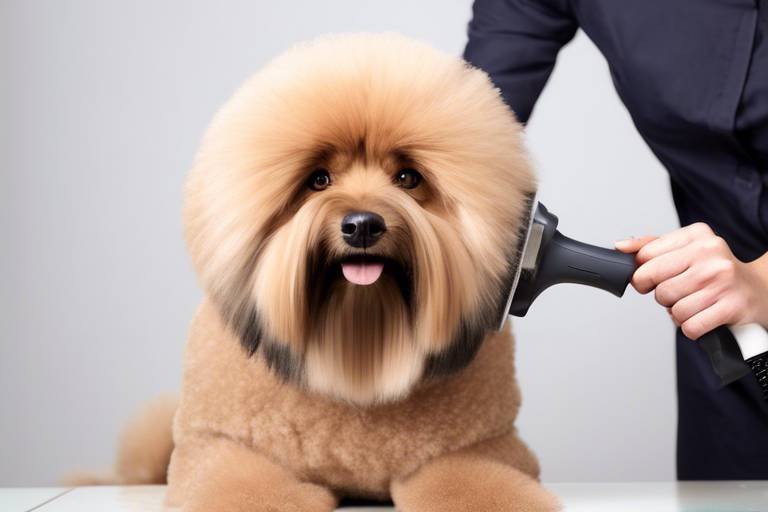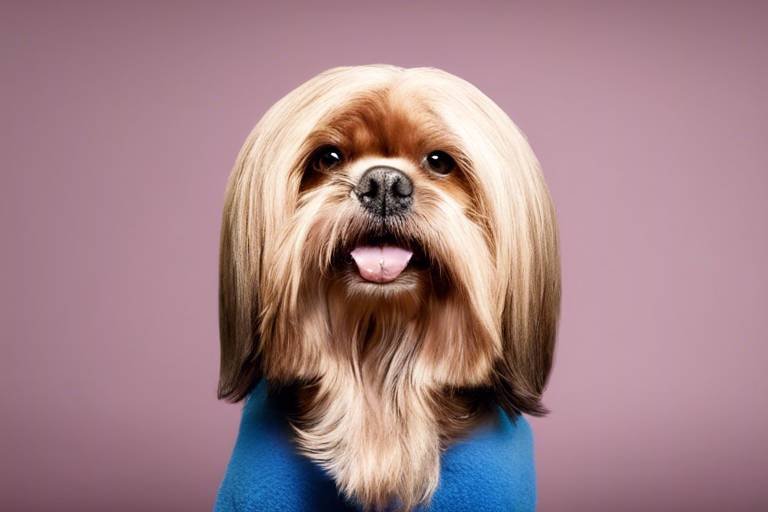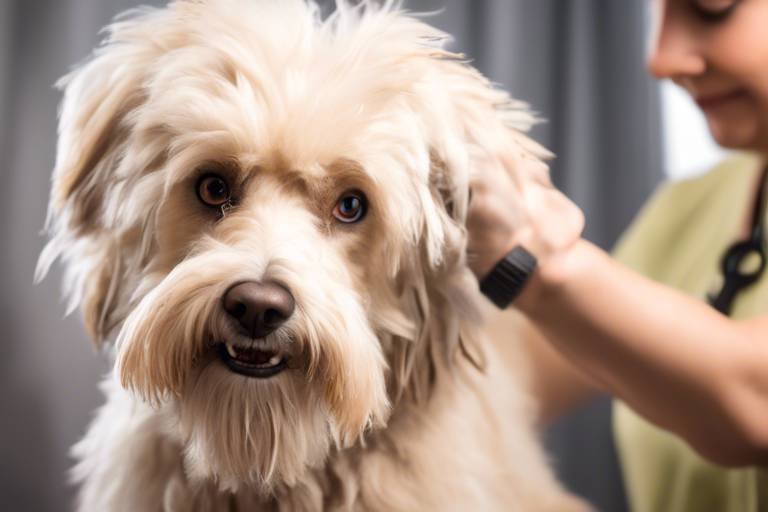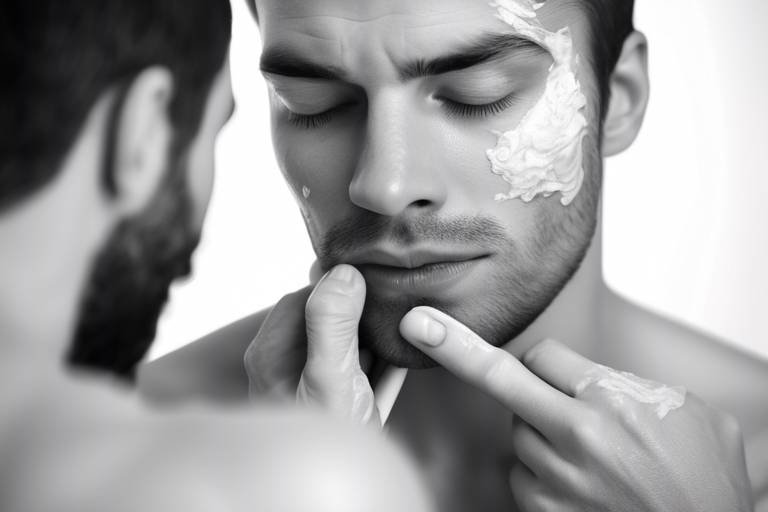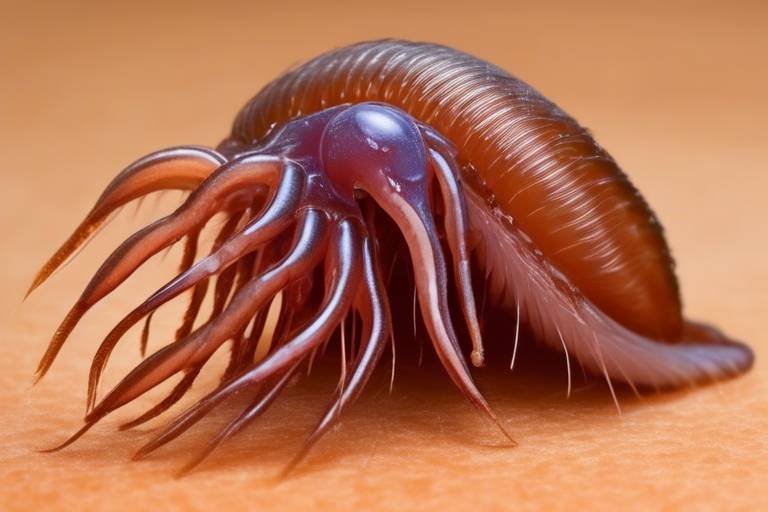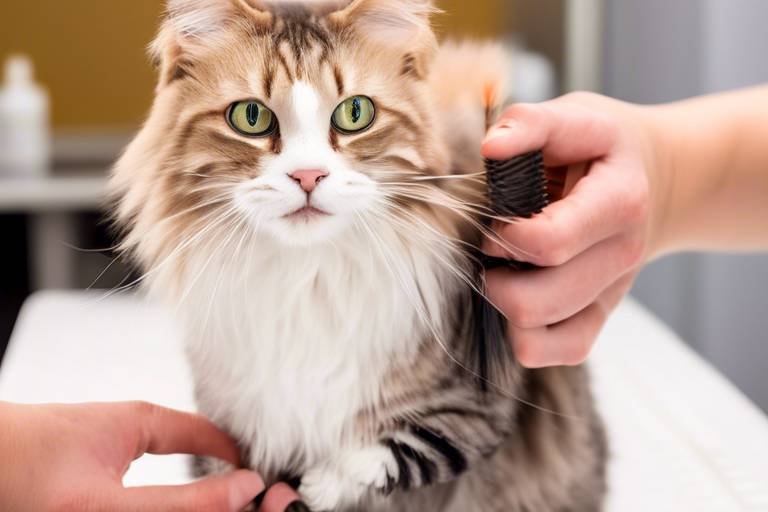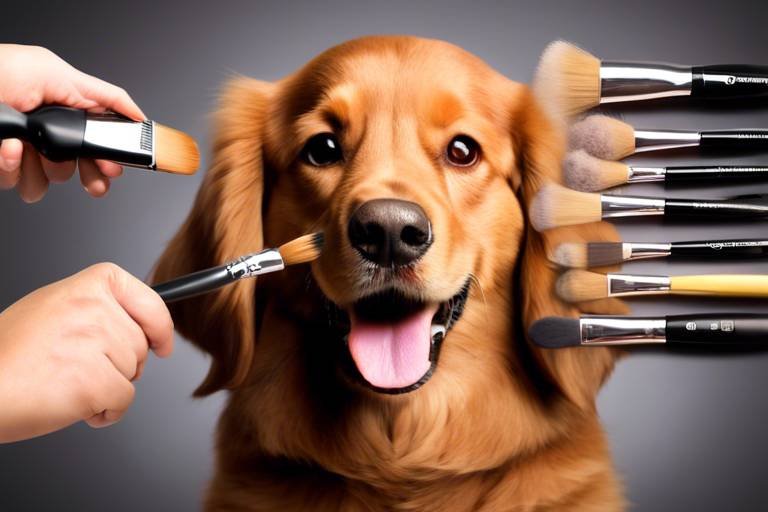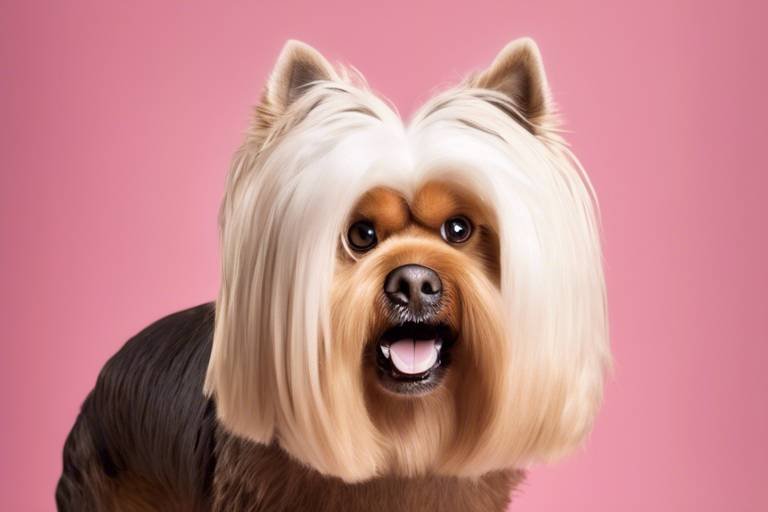How to Prevent Grooming-Related Injuries
Grooming your pet can be a delightful experience, but it can also pose risks if not approached with care. Whether you're trimming nails, brushing fur, or giving a bath, grooming-related injuries can happen to both pets and their owners. The key to a successful grooming session lies in understanding these risks and taking proactive steps to mitigate them. In this article, we'll explore effective strategies and best practices that will help ensure safety during grooming activities, making the process enjoyable for everyone involved.
Grooming-related injuries can manifest in various forms, and they often arise from the tools we use or the techniques we employ. Common types of injuries include cuts from scissors or clippers, skin irritations from improper brushing, and even stress-induced injuries due to anxiety. For instance, a pet may bite or scratch if it feels uncomfortable or frightened during the grooming process. Therefore, it's crucial to be aware of these potential hazards and implement preventive measures to keep both you and your furry friend safe.
Using the right tools is vital for ensuring a smooth and safe grooming experience. The tools you choose can significantly impact the outcome of the grooming session and the safety of both you and your pet. Here, we will examine some essential grooming tools that help reduce the risk of injuries:
| Tool | Purpose | Safety Tips |
|---|---|---|
| Brushes | Remove loose fur and prevent matting | Choose a brush suitable for your pet's coat type |
| Scissors | Trim fur around sensitive areas | Use rounded-tip scissors to avoid accidental cuts |
| Clippers | Trim fur quickly and efficiently | Ensure clippers are well-maintained and sharp |
When it comes to brushes, selecting the appropriate one for your pet's coat type is essential. For instance, long-haired breeds require different brushes compared to short-haired ones. Using the wrong brush can lead to skin irritation or discomfort for your pet. Always look for brushes that are specifically designed for your pet's needs, and consider the following:
- For long-haired pets, a wide-toothed comb or slicker brush works best.
- Short-haired breeds benefit from bristle brushes or rubber grooming mitts.
Accidental cuts are a common concern during grooming, but using the right tools can minimize this risk. Opt for scissors with rounded tips, especially when working near sensitive areas like the face or paws. Additionally, ensure that your clippers are designed for pet grooming and are in good working condition. Dull blades can pull on the fur, causing pain and increasing the chances of injury. Always follow the manufacturer's instructions for safe use, and take your time to avoid rushing through the grooming process.
Employing proper grooming techniques is crucial for ensuring safety during grooming sessions. One of the most important aspects is to remain calm and patient, as pets can sense your anxiety. If your pet seems restless or anxious, take a moment to pause and reassess the situation. Calmly speaking to your pet can help ease their nerves. Additionally, consider the following techniques:
Many pets experience anxiety during grooming, which can lead to unpredictable behavior. To help calm your furry friend, try using soothing techniques such as:
- Playing soft music to create a relaxing atmosphere.
- Offering treats to create positive associations with grooming.
- Using pheromone sprays designed to reduce anxiety.
Just like us, pets can become fatigued or stressed during extended grooming sessions. It's essential to pace yourself and your pet by incorporating regular breaks. Not only does this help prevent injuries, but it also allows your pet to relax and recharge. During these breaks, you can offer a treat or engage in a quick play session to keep their spirits high.
Being attentive to your pet's body language is crucial in preventing injuries. Signs of distress can include:
- Whining or whining
- Excessive panting
- Attempting to escape
If you notice any of these signs, it's essential to stop grooming immediately and address your pet's needs. This could mean taking a break, offering comfort, or even postponing the grooming session until your pet feels more at ease.
Finally, establishing a safe grooming environment is fundamental to injury prevention. Ensure that your grooming space is free from clutter and hazards. Here are some tips for creating a safe grooming area:
- Use a non-slip mat to prevent slipping.
- Keep all tools organized and within reach to avoid accidents.
- Ensure adequate lighting to see what you're doing clearly.
By following these guidelines, you can create a safe and comfortable grooming environment for both you and your pet.
Q: How often should I groom my pet?
A: The frequency of grooming depends on your pet's breed and coat type. Long-haired breeds may require grooming several times a week, while short-haired breeds might only need it once a month.
Q: What should I do if my pet is anxious during grooming?
A: Try to create a calm environment, use soothing techniques, and take breaks to help your pet feel more comfortable. If anxiety persists, consult with a veterinarian or professional groomer for additional strategies.
Q: Are there any grooming tools I should avoid?
A: Avoid using human grooming tools on pets, as they are not designed for their unique needs. Always opt for tools specifically made for pet grooming.
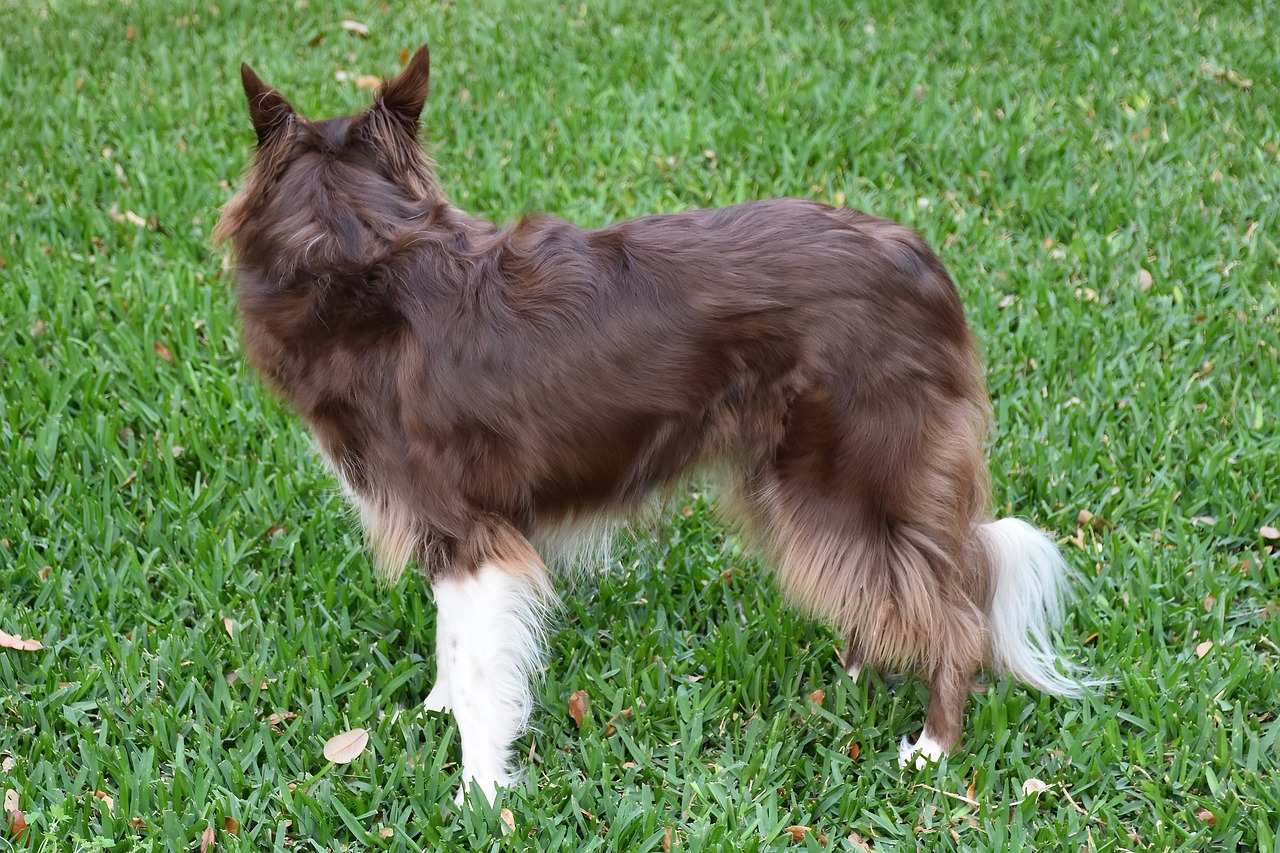
Understanding Grooming-Related Injuries
Grooming is an essential part of pet care, but it can sometimes lead to injuries for both pets and their owners. Understanding the nature of these injuries is the first step in preventing them. Common grooming-related injuries include cuts, abrasions, and even emotional distress. These injuries often arise from improper handling, the use of inappropriate tools, or a lack of knowledge about the pet's behavior. For instance, a sudden jerk from a frightened pet can lead to accidental cuts with scissors or clippers. It's crucial to be aware of these risks to ensure a safe grooming experience.
One of the most frequent types of injuries occurs during the use of clippers and scissors. If not handled correctly, these tools can cause painful nicks and cuts. Additionally, pets can suffer from skin irritations if the wrong brushes are used or if they are brushed too aggressively. It’s important to recognize that grooming is not just a physical task; it also involves understanding your pet's emotional state. Pets that are anxious or fearful can react unpredictably, which may lead to injuries.
To illustrate the risks involved, consider the following table that outlines common grooming-related injuries, their causes, and some preventive measures:
| Type of Injury | Causes | Preventive Measures |
|---|---|---|
| Cuts and Nicks | Improper tool usage, sudden movements | Use appropriate scissors and clippers; handle with care |
| Skin Irritations | Wrong brushes, excessive force | Select suitable brushes; be gentle |
| Emotional Distress | Anxiety in pets, unfamiliar environment | Calm the pet; create a comfortable space |
Being aware of these injuries and their causes can significantly reduce the risk during grooming sessions. It’s not only about the physical tools you use but also about understanding your pet's behavior and emotional needs. By adopting a cautious approach and being mindful of your pet's reactions, you can create a safer grooming experience for both you and your furry friend.
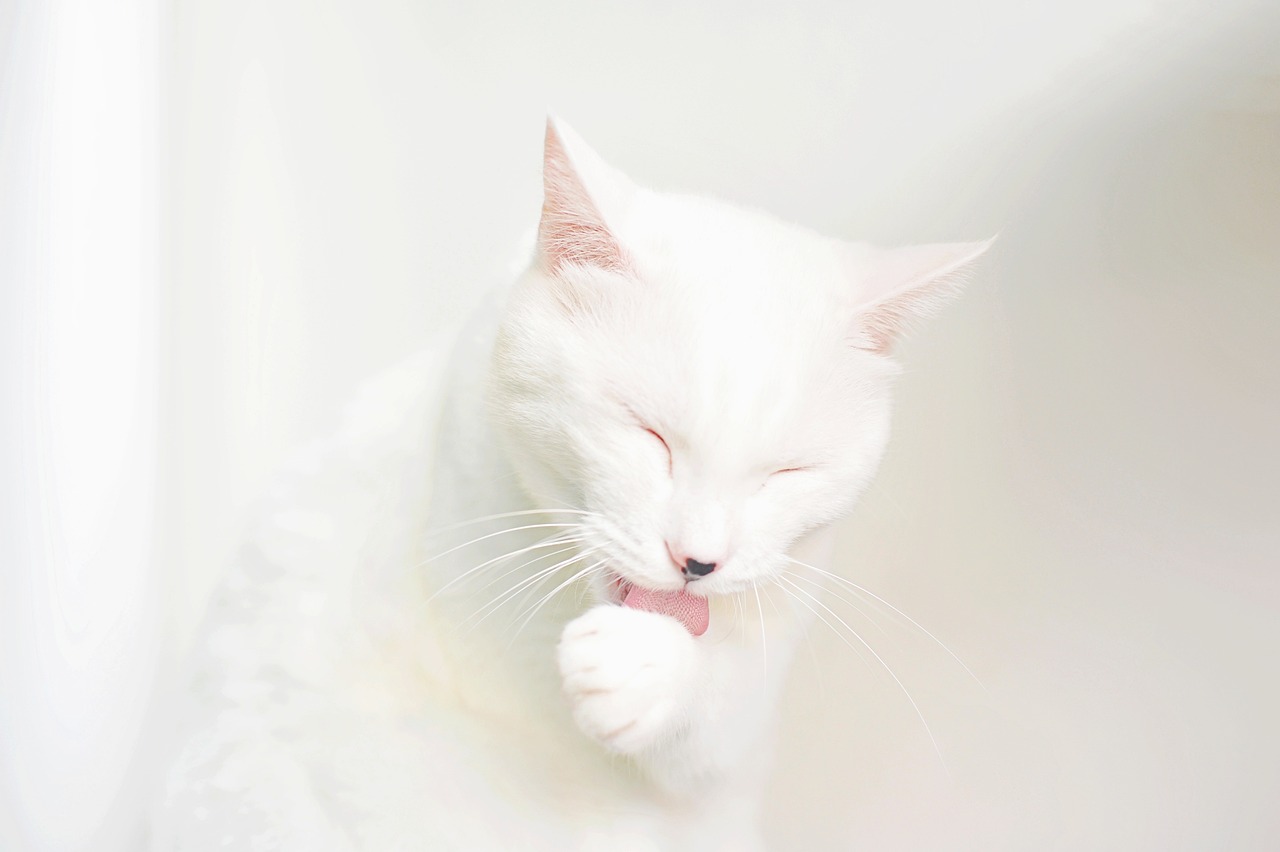
Essential Tools for Safe Grooming
When it comes to grooming your beloved pet, having the right tools is not just a luxury—it's a necessity. Using the correct grooming equipment can significantly reduce the risk of injuries, ensuring both you and your furry friend have a smooth experience. Imagine trying to cook a gourmet meal without the right utensils; it would be chaotic, right? The same principle applies to grooming. Let's dive into the essential tools that every pet owner should have in their arsenal.
First and foremost, brushes are a fundamental part of grooming. The type of brush you choose can make all the difference. For instance, slicker brushes are fantastic for removing mats and tangles in long-haired breeds, while bristle brushes work wonders for short-haired pets. If you're unsure about which brush to use, consider the following:
| Coat Type | Recommended Brush | Purpose |
|---|---|---|
| Long Hair | Slicker Brush | Removes tangles and mats |
| Short Hair | Bristle Brush | Distributes natural oils |
| Curly Hair | Pin Brush | Untangles and smooths |
Next up are scissors and clippers. These tools are vital for trimming fur and managing any unruly patches. However, safety is paramount when using these sharp instruments. Look for scissors that have rounded tips to minimize the risk of accidental cuts. Similarly, when choosing clippers, opt for those that are designed specifically for pets, as they tend to be quieter and less intimidating. Remember, a calm pet is a safe pet!
Another essential tool is a de-shedding tool. If you've ever been covered in pet hair after a grooming session, you know how important this tool can be. De-shedding tools help to remove loose fur and reduce shedding, making your home cleaner and your pet more comfortable. Think of it as a magic wand that transforms your grooming sessions from chaotic to calm.
Finally, don't overlook the importance of grooming gloves. These aren't just for looks; they serve a dual purpose. Not only do they help remove loose fur, but they also provide a gentle massaging effect that can soothe anxious pets. It's like giving your pet a spa day while keeping your hands safe from scratches and bites!
In conclusion, investing in the right grooming tools is crucial for a safe and effective grooming experience. By equipping yourself with the proper brushes, scissors, clippers, de-shedding tools, and grooming gloves, you're setting the stage for a successful grooming session. Remember, a well-groomed pet is a happy pet, and a happy pet makes for a happy owner!
Q: How often should I groom my pet?
A: The frequency of grooming depends on your pet's coat type. Long-haired pets may require grooming several times a week, while short-haired pets might only need it once a month.
Q: Can I use human grooming tools on my pet?
A: It's best to use tools specifically designed for pets. Human grooming tools can be too harsh and may cause injuries.
Q: What should I do if my pet is anxious during grooming?
A: Consider using calming techniques, such as soft music or treats, to help soothe your pet. Taking breaks can also help reduce anxiety.
Choosing the Right Brushes
When it comes to grooming your furry friend, selecting the right brush is crucial for both their comfort and your success. Imagine trying to untangle a ball of yarn with a fork—frustrating, right? That's exactly how your pet feels when you use the wrong brush! Different coat types require different brushes, and using the appropriate one can make all the difference in preventing skin irritation and injuries.
For instance, if your pet has a long, flowing coat, a slicker brush is often ideal. This type of brush features fine, short wires close together, which effectively removes mats and tangles without pulling on the skin. On the other hand, if you're grooming a short-haired breed, a bristle brush might be more suitable, as it helps distribute natural oils and keeps the coat shiny. Understanding your pet's specific coat type is essential, so let’s break it down a bit more:
| Coat Type | Recommended Brush Type | Benefits |
|---|---|---|
| Long Hair | Slicker Brush | Removes tangles and prevents mats |
| Short Hair | Bristle Brush | Distributes oils, adds shine |
| Curly Hair | Pin Brush | Prevents matting and removes loose hair |
| Wire Hair | Undercoat Rake | Removes dead hair and undercoat |
Before diving into the grooming session, it’s also a good idea to familiarize yourself with your pet's preferences. Some pets may have sensitive skin, so starting with a softer brush can ease them into the process. You might also want to consider a brush with an ergonomic handle. Just like you wouldn’t want to hold a heavy suitcase for too long, a comfortable grip can make a grooming session much more enjoyable for you.
Finally, don’t forget to clean your brushes regularly! Just as we need to wash our hairbrushes to keep them effective, your pet’s brushes need care too. This not only prolongs the life of the brushes but also ensures that any accumulated dirt or hair doesn’t irritate your pet’s skin during grooming. So, remember, the right brush is not just about the tool itself, but also about how you use and maintain it.
- How often should I brush my pet? It depends on the coat type. Long-haired pets may need daily brushing, while short-haired ones might only require it weekly.
- Can I use human brushes on pets? It's best to use brushes specifically designed for pets, as human brushes may not effectively remove loose hair or could irritate their skin.
- What should I do if my pet hates being brushed? Start slowly and use treats to create a positive association with grooming. You might also try different brushes to find one they prefer.
Safe Scissors and Clippers
When it comes to grooming your beloved pets, using is not just important; it's absolutely essential. Imagine trying to cut your own hair with dull scissors—frustrating, right? Now, think about how your furry friend feels when you wield a pair of clippers that aren't designed for their specific needs. Accidental cuts can lead to not only physical injuries but also emotional trauma for your pet. Therefore, investing in the right tools is like putting on a seatbelt before driving; it’s a safety measure that can prevent serious mishaps.
So, what should you look for when choosing scissors and clippers? First and foremost, consider the type of grooming you will be doing. For instance, if you're just trimming around the paws or ears, a pair of rounded-tip scissors is a fantastic option. These are designed to minimize the risk of cutting your pet’s skin. On the other hand, if you're dealing with a long-haired breed that requires regular clipping, investing in a quality set of clippers is vital. Look for clippers that are lightweight and have adjustable speed settings, so you can tailor the grooming experience to your pet's comfort level.
Additionally, ensure that the blades are made from high-quality materials and are easy to clean. This not only prolongs the life of the tools but also ensures that your pet is not exposed to any bacteria or irritants. A quick maintenance routine, such as oiling the blades and cleaning them after each use, can make a world of difference.
Don’t forget about the noise factor! Many pets are sensitive to loud sounds, so consider using silent clippers or those designed to operate quietly. This can help keep your pet calm during the grooming process. If your pet is particularly anxious, you might even want to introduce them to the sound of the clippers before the actual grooming session. This way, they'll associate the noise with something positive rather than a scary experience.
| Tool Type | Best Use | Safety Features |
|---|---|---|
| Rounded-Tip Scissors | Trimming sensitive areas | Prevents accidental cuts |
| Clippers | Full body grooming | Adjustable speed, quiet operation |
| Thinning Shears | Blending fur | Reduces bulk without cutting |
In summary, using safe scissors and clippers is a crucial part of the grooming process. By selecting the right tools and maintaining them properly, you can significantly reduce the risk of injuries. Remember, the goal is to create a positive grooming experience for both you and your pet. After all, a well-groomed pet is a happy pet!
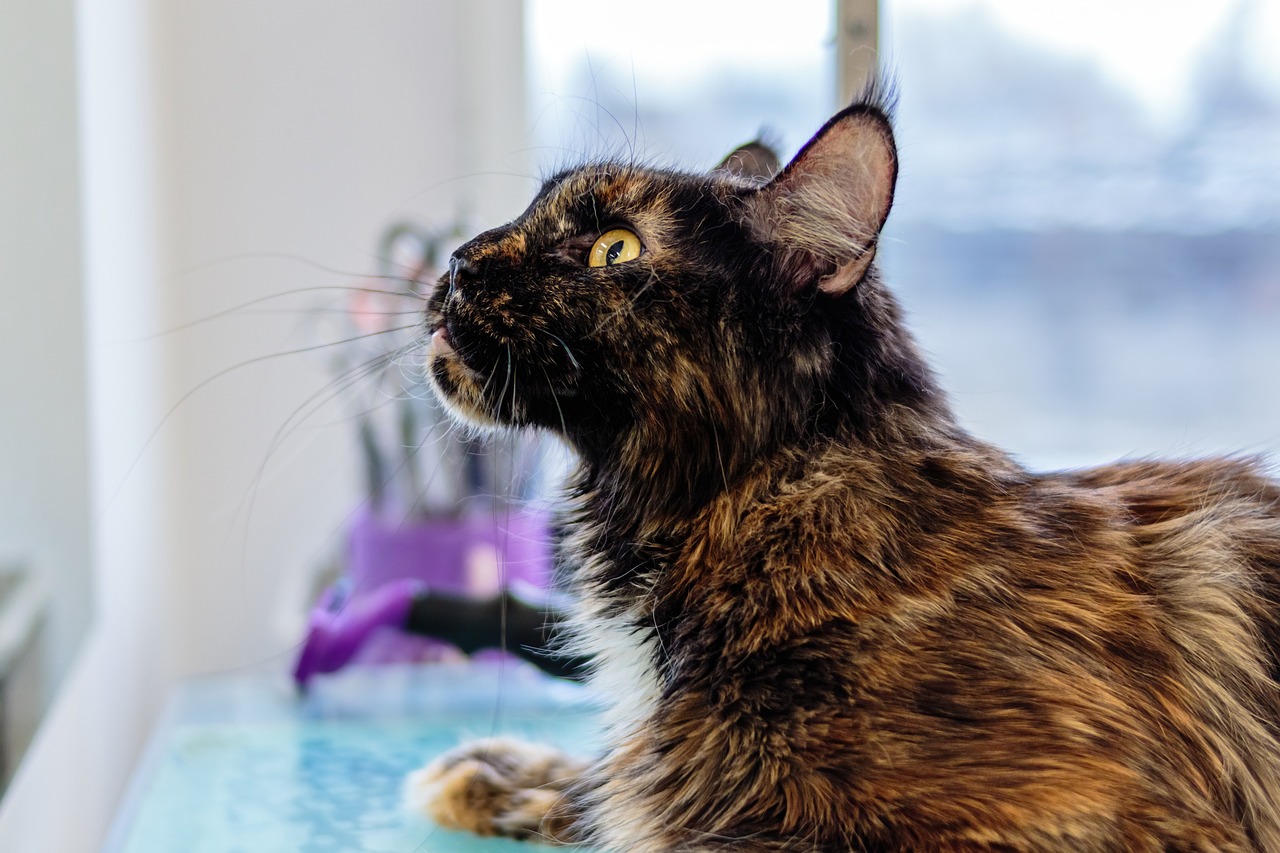
Proper Grooming Techniques
When it comes to grooming your pet, employing proper techniques is not just about aesthetics; it's about ensuring the safety and comfort of both you and your furry friend. Grooming can be a delightful bonding experience, but it can also lead to injuries if not done correctly. So, how do you make grooming a safe and enjoyable process? Let’s dive into some essential techniques that will help you avoid accidents and keep your pet looking their best.
First and foremost, patience is key. Rushing through grooming can lead to mistakes, which may result in injuries. Take your time, and don’t hesitate to pause if your pet seems uncomfortable. Remember, grooming isn’t a race; it’s a shared experience. If your pet is particularly anxious, consider breaking the grooming session into smaller parts. This not only helps your pet get used to the process but also gives you both a chance to relax. A good rule of thumb is to groom for about 10-15 minutes at a time, then take a break. During these breaks, you can offer treats or engage in some light play to keep the mood positive.
Another crucial aspect is to maintain a calm atmosphere. Pets can pick up on their owner's emotions, so if you’re feeling stressed or hurried, your pet will likely feel the same way. Play some soft music or talk to your pet in a soothing voice. This can create a more relaxed environment, making it easier for them to accept grooming. You might be surprised at how much your tone of voice can influence their behavior!
When it comes to the actual grooming, technique matters. For instance, when brushing your pet, always start from the back and work your way forward. This method is less intimidating for your pet and allows you to gauge their comfort level as you go. If you encounter any tangles, use a detangling spray and gently work through them with your fingers or a wide-toothed comb. Remember, pulling too hard can cause pain and lead to injuries. It's all about being gentle and attentive.
For pets that are particularly anxious or fidgety, consider using a grooming restraint system. These devices can help keep your pet still without causing them distress. Always ensure that any restraint used is comfortable and does not restrict their breathing or movement too much. It’s essential to create a balance between keeping them secure and allowing them enough freedom to feel safe.
Additionally, be mindful of your pet's body language. If they start to show signs of distress—like whining, growling, or trying to escape—it's crucial to stop and reassess the situation. Sometimes, a little break or a change in technique can make all the difference. Never ignore these signals; they are your pet's way of communicating that something isn't right.
Finally, don't forget to reward your pet after a grooming session. Positive reinforcement is a powerful tool. Whether it's a treat, a favorite toy, or some extra cuddle time, rewarding your pet will help them associate grooming with positive experiences. This can make future grooming sessions much smoother and more enjoyable for both of you.
In summary, proper grooming techniques are vital for minimizing the risk of injuries. By being patient, maintaining a calm environment, using the right tools, and being attentive to your pet’s needs, you can turn grooming from a stressful chore into a fun and safe bonding experience.
To help you navigate the world of pet grooming, here are some frequently asked questions:
- How often should I groom my pet? - This depends on the breed and coat type. Long-haired breeds may need grooming several times a week, while short-haired breeds might only need it once a month.
- What should I do if my pet is aggressive during grooming? - If your pet shows aggression, it's best to consult a professional groomer or a veterinarian. They can provide guidance on how to handle the situation safely.
- Can I groom my pet at home? - Absolutely! With the right tools and techniques, home grooming can be effective. Just remember to be patient and take your time.
Handling Anxiety in Pets
Grooming can be a stressful experience for many pets, especially if they are not accustomed to the process. Just like humans can feel anxious before a big event, pets can experience similar feelings when they know it’s time for grooming. Understanding how to handle this anxiety is crucial for creating a safe and comfortable environment for both pets and their owners. So, how can we make grooming a more enjoyable experience for our furry friends?
The first step in alleviating anxiety is to create a calm atmosphere. This can be achieved by using soothing sounds, such as soft music or white noise, which can help drown out any frightening noises from the grooming tools. Additionally, consider the lighting in your grooming area; soft, natural light can help create a more relaxed environment. Remember, a calm space leads to a calm pet!
Another effective technique is to introduce grooming tools gradually. Instead of bringing out all the clippers, brushes, and scissors at once, take your time. Allow your pet to sniff and explore the tools while they are turned off. This can help demystify the grooming process and make your pet feel more at ease. You might also want to reward your pet with treats and praise during this introduction, reinforcing positive associations with grooming.
When it’s time to start grooming, consider using gentle handling techniques. Approach your pet slowly and calmly, allowing them to get used to your presence. Use a soft voice to reassure them, and start with simple tasks, such as brushing a small section of their coat. If your pet shows signs of distress, such as growling, whining, or trying to escape, take a step back. It’s essential to recognize these signs and adjust your approach accordingly. Sometimes, less is more, and taking it slow can make a world of difference.
Furthermore, desensitization techniques can be incredibly beneficial. This involves gradually introducing your pet to the grooming process over a series of sessions. For example, you might start by simply petting your dog for a few minutes, then slowly introduce brushing for short intervals. By breaking the process down into manageable chunks, you can help your pet build confidence and reduce their anxiety over time.
Finally, consider the option of professional help. If your pet’s anxiety is severe, it may be worth consulting a professional groomer or a veterinarian. They can provide additional strategies tailored to your pet’s specific needs and may even recommend calming products, such as anxiety wraps or pheromone diffusers. Just like we sometimes need a helping hand, our pets can benefit from expert advice too!
In summary, handling anxiety in pets during grooming requires patience, understanding, and a few strategic techniques. By creating a calm environment, introducing tools gradually, using gentle handling, employing desensitization techniques, and seeking professional help when necessary, you can transform grooming from a stressful ordeal into a positive bonding experience. After all, a happy pet means a happier grooming session!
- What are the signs of anxiety in pets during grooming? Look for behaviors such as trembling, hiding, excessive barking, or attempts to escape.
- How can I make grooming more enjoyable for my pet? Use treats, praise, and a calm atmosphere to create positive associations with grooming.
- Should I seek professional help for my anxious pet? Yes, if your pet's anxiety is severe, consulting a professional can provide tailored strategies and support.
Taking Breaks During Grooming
Grooming your pet can be a delightful experience, but it can also become overwhelming for both you and your furry friend. Just like humans, pets can experience fatigue and stress during grooming sessions, which is why taking breaks is essential. Think of grooming as a marathon, not a sprint. It’s all about pacing yourself and your pet to keep things smooth and enjoyable. But how do you know when to take a break? And why is it so important?
First off, it’s crucial to recognize that grooming isn’t just about making your pet look good; it’s about their overall well-being too. Long grooming sessions can lead to anxiety, restlessness, and even physical discomfort for pets. Just like us, they can become irritable and less cooperative if they feel overwhelmed. So, taking regular breaks allows your pet to relax, recharge, and come back to the grooming table ready to cooperate.
Here are a few signs that indicate it might be time for a break:
- Restlessness: If your pet is fidgeting or trying to escape, it’s a clear sign they need a breather.
- Panting: Excessive panting can indicate stress or discomfort.
- Loss of focus: If your pet seems distracted or disinterested, it’s time to pause.
During these breaks, it’s a good idea to engage in calming activities. You could offer a favorite toy, some soothing pet music, or even a gentle belly rub. This not only helps to relax your pet but also strengthens your bond. Plus, it gives you a moment to collect your thoughts and prepare for the next phase of grooming.
Another aspect to consider is the duration of your grooming sessions. For instance, if you’re working on a larger breed with a thick coat, it might be wise to break the grooming into smaller, manageable chunks. Instead of trying to tackle the entire grooming process in one go, consider splitting it into two or three sessions. This approach not only reduces stress but also allows you to do a more thorough job without rushing.
To help you plan effective grooming breaks, here’s a simple table outlining recommended grooming session lengths based on your pet’s size and coat type:
| Pet Size | Coat Type | Recommended Session Length | Break Duration |
|---|---|---|---|
| Small | Short Hair | 15-20 minutes | 5 minutes |
| Small | Long Hair | 20-30 minutes | 10 minutes |
| Medium | Short Hair | 20-30 minutes | 5-10 minutes |
| Medium | Long Hair | 30-40 minutes | 10 minutes |
| Large | Short Hair | 30-40 minutes | 10-15 minutes |
| Large | Long Hair | 40-60 minutes | 15 minutes |
By adhering to these guidelines, you can create a more enjoyable grooming experience that prioritizes your pet's comfort and safety. Remember, grooming is not just a chore; it’s a chance to connect with your pet and ensure they feel loved and cared for. So, take those breaks, give your pet some love, and make grooming a fun and stress-free activity!
Q: How often should I groom my pet?
A: It depends on the breed and coat type. Generally, short-haired pets can be groomed every few weeks, while long-haired breeds may need weekly grooming.
Q: What should I do if my pet becomes anxious during grooming?
A: Try to create a calm environment, use soothing voices, and take breaks as needed. You can also consult a vet for anxiety management strategies.
Q: Is it necessary to use professional grooming services?
A: While many pet owners can groom their pets at home, professional groomers can be beneficial for complex grooming needs or for pets that require specialized care.

Recognizing Signs of Distress
When it comes to grooming your furry friend, being able to recognize signs of distress is absolutely crucial. Just like us, pets have their own ways of expressing discomfort or anxiety, and understanding these signals can make a world of difference. Imagine trying to get a haircut while feeling nervous; you'd likely squirm and fidget, right? Our pets are no different. By being observant, you can create a safer, more comfortable grooming experience for both you and your pet.
One of the first signs of distress to look for is body language. If your pet is stiffening up or trying to pull away, it’s a clear indication they’re not feeling comfortable. Pay attention to their ears; if they’re pinned back or flicking rapidly, that’s often a sign of stress. Additionally, a pet that’s constantly licking its lips or yawning might be trying to calm itself down. These behaviors can be subtle, but they’re important cues that shouldn’t be ignored.
Another common sign of distress is vocalization. If your pet suddenly starts whining, growling, or barking more than usual during grooming, it’s time to take a step back and assess the situation. Just like a child might cry if they’re scared, your pet uses their voice to communicate their feelings. If you notice these sounds, try to soothe them with a gentle voice or a comforting touch. You might even consider taking a break to let them calm down.
Sometimes, pets will exhibit physical signs of distress, such as excessive shedding or trembling. If you notice your pet losing fur at an alarming rate or shaking uncontrollably, it’s essential to stop grooming immediately. These physical reactions are often their way of saying, “I’m not okay!” In such cases, it’s best to take a moment to evaluate the grooming environment and your pet's comfort level.
To help you identify these signs more effectively, here’s a quick reference table summarizing common signs of distress in pets:
| Sign of Distress | Description |
|---|---|
| Body Language | Pinned ears, stiff body, or trying to pull away. |
| Vocalization | Whining, growling, or excessive barking. |
| Physical Signs | Excessive shedding, trembling, or hiding. |
| Calming Behaviors | Licking lips, yawning, or looking away. |
Recognizing these signs not only helps in preventing injuries but also fosters a trusting relationship between you and your pet. If you notice any signs of distress, don’t hesitate to pause the grooming session. Take a moment to reassure your pet, perhaps with a gentle pet or a treat. This not only calms them down but also helps them associate grooming with positive experiences. Remember, grooming should be a bonding time, not a battle!
Q: What should I do if my pet shows signs of distress during grooming?
A: If your pet shows signs of distress, take a break. Reassure them with a calm voice and gentle touch. Consider resuming grooming later or seeking professional help if needed.
Q: How can I help my anxious pet feel more comfortable during grooming?
A: Gradually introduce your pet to grooming tools and techniques. Use treats and praise to create a positive association, and consider short, frequent grooming sessions.
Q: Are there specific signs of distress that are more common in certain breeds?
A: Yes, some breeds may be more prone to anxiety or distress than others. Research your pet's breed characteristics and tailor your grooming approach accordingly.
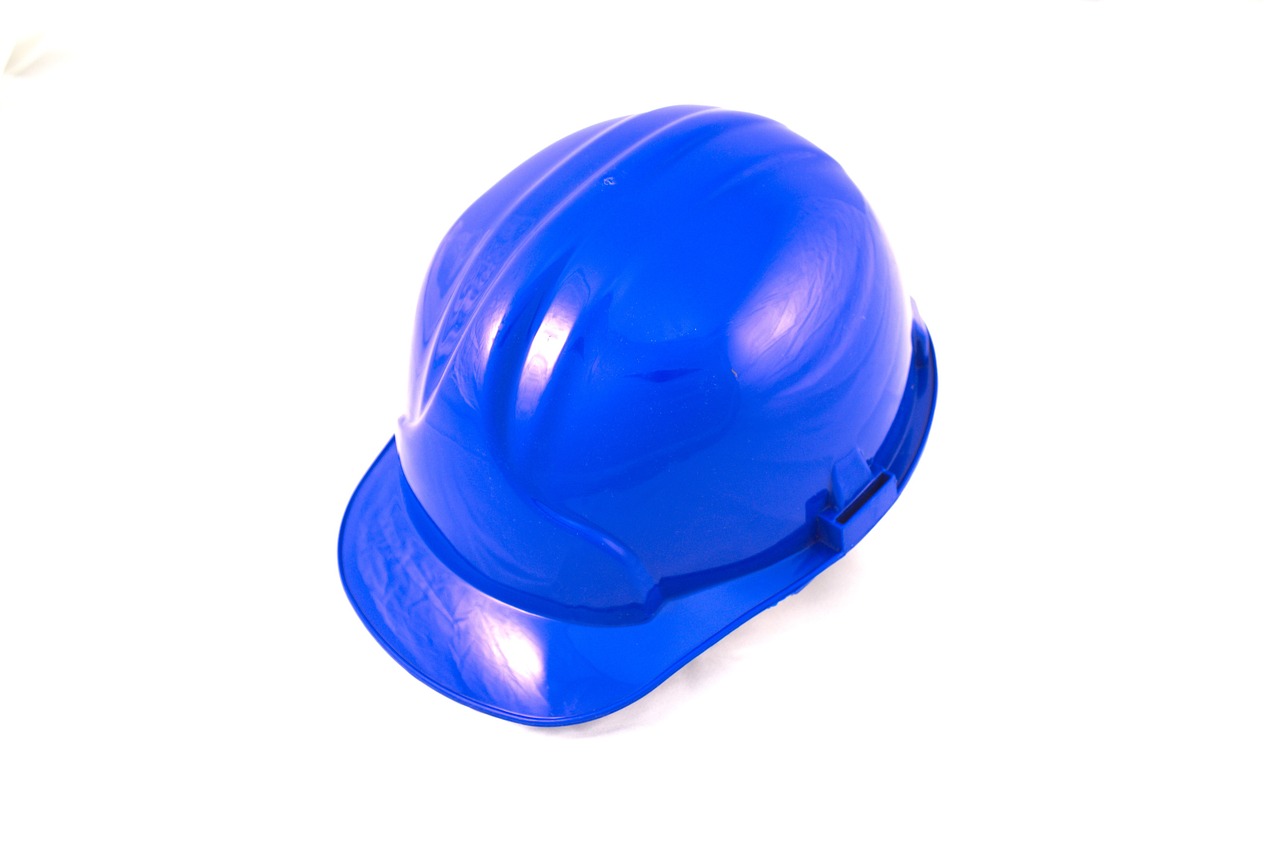
Creating a Safe Grooming Environment
When it comes to grooming our beloved pets, creating a safe environment is just as important as using the right tools and techniques. Imagine trying to navigate a busy road without any traffic signals; it can be chaotic and dangerous. Similarly, a grooming space that isn't set up correctly can lead to accidents and injuries, both for the pet and the groomer. So, how do we ensure that our grooming area is as safe as possible? Let’s break it down.
First and foremost, choose a designated grooming area that is free from distractions and hazards. This could be a specific room or a corner of your home that is quiet and calm. Make sure the space is well-lit, as good visibility can help you see what you’re doing and spot any potential issues before they escalate. Just like a well-lit stage makes for a better performance, a bright grooming area allows for better focus and control.
Next, consider the flooring. A non-slip surface is essential to prevent both you and your pet from slipping during the grooming process. If your grooming area has tiles or hardwood floors, think about adding a rubber mat to create a more stable footing. This is especially important if your pet tends to move around a lot or if you’re using tools that require you to be on your feet for extended periods. A secure footing can make all the difference in maintaining balance and composure.
Another critical aspect is to keep all your grooming tools organized and within reach. Use a grooming cart or a toolbox to store your brushes, clippers, scissors, and shampoos. This not only keeps your area tidy but also minimizes the risk of accidents. Imagine searching for a tool in the middle of a grooming session—it's like trying to find a needle in a haystack! By having everything organized, you can focus on grooming rather than rummaging through clutter.
Additionally, ensure that your grooming space is pet-proofed. Remove any items that could be harmful, such as electrical cords, small objects that could be swallowed, or toxic plants. Think of it as setting up a safe playground for your furry friend; everything should be in place to prevent any potential injuries. If your pet is particularly curious, consider using barriers or gates to limit their access to hazardous areas.
Lastly, always have a first aid kit readily available in your grooming area. Accidents can happen, and being prepared can make a significant difference. Include essentials such as antiseptic wipes, bandages, and any necessary medications. Just like a fire extinguisher in a kitchen, having a first aid kit nearby can provide peace of mind and ensure a quick response to any mishaps.
In summary, creating a safe grooming environment involves careful planning and consideration. By ensuring that your grooming area is distraction-free, well-lit, and organized, you can significantly reduce the risk of injuries. Remember, a little preparation goes a long way in ensuring a smooth and safe grooming experience for both you and your pet!
- What should I include in my grooming first aid kit? A good grooming first aid kit should include antiseptic wipes, bandages, tweezers, and any specific medications your pet may need.
- How can I calm my pet during grooming? Use calming techniques such as gentle petting, soft talking, and providing treats to create a relaxing atmosphere.
- Is it necessary to have a designated grooming space? Yes, having a specific area helps to minimize distractions and keeps everything organized for a safer grooming experience.
Frequently Asked Questions
- What are the most common grooming-related injuries?
Grooming-related injuries can vary, but some of the most common include cuts from scissors or clippers, skin irritations from improper brushing, and injuries caused by anxious pets who may bite or scratch. Understanding these risks is crucial for both pet owners and professional groomers.
- How can I choose the right grooming tools for my pet?
Choosing the right grooming tools is essential for a safe and effective grooming experience. Look for brushes that suit your pet's coat type, and ensure that scissors and clippers are designed for pet use. Always prioritize quality over cost to minimize the risk of injuries.
- What should I do if my pet shows signs of anxiety during grooming?
If your pet shows signs of anxiety, such as trembling or trying to escape, take a step back. Use calming techniques like gentle petting, soothing words, or even breaks during grooming. This approach helps create a more relaxed environment and reduces the risk of injury.
- How often should I take breaks during grooming?
It's a good idea to take breaks every 15 to 20 minutes, especially for longer grooming sessions. This not only helps to keep your pet calm but also allows you to avoid fatigue, making the experience safer and more enjoyable for both of you.
- What signs of distress should I look for in my pet?
Pay attention to your pet's body language. Signs of distress can include growling, whining, excessive licking, or attempting to escape. If you notice any of these behaviors, it's important to pause grooming and address their needs before continuing.
- How can I create a safe grooming environment?
To create a safe grooming environment, ensure that the area is well-lit and free from hazards. Use non-slip mats to prevent slipping, keep tools organized and out of reach when not in use, and make sure your pet is comfortable in the space. A calm environment promotes safety and reduces stress.



